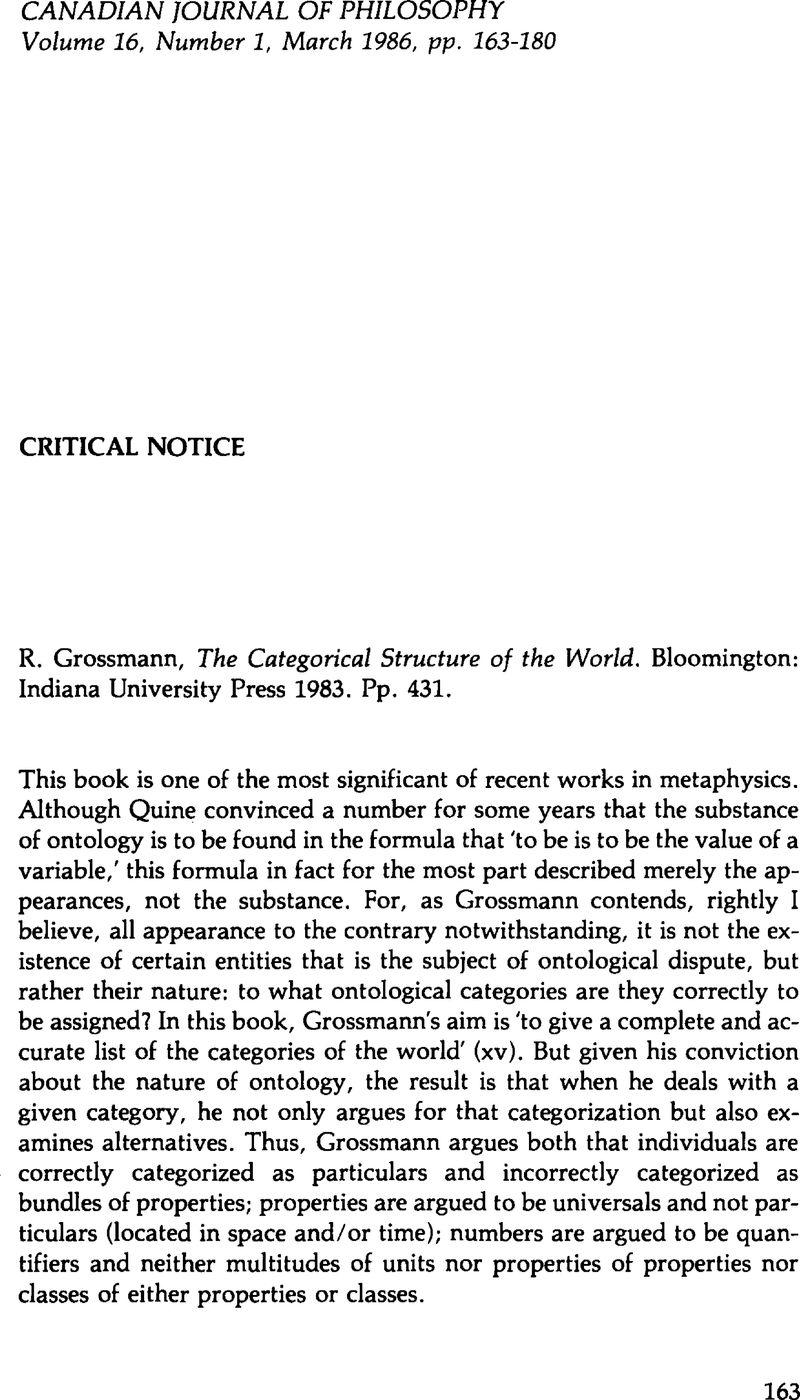No CrossRef data available.
Article contents
R. Grossmann, The Categorical Structure of the World. Bloomington: Indiana University Press 1983. Pp. 431.
Published online by Cambridge University Press: 01 January 2020
Abstract

- Type
- Critical Notice
- Information
- Copyright
- Copyright © The Authors 1986
References
1 Cf. also Wilson, F. ‘Acquaintance, Ontology, and Knowledge,’ The New Scholasticism 54 (1970) 1–48CrossRefGoogle Scholar; and ‘Effability, Ontology and Method,’ Philosophy Research Archives 9 (1983) 419-70.
2 Conversely, neither are properties reducible to classes. For greater detail on all this, see Grossmann's Ontological Reduction (Bloomington: University of Indiana Press 1973), esp. Part II.
3 See also Grossmann, Ontological Reduction, Part One.
4 See also Grossmann, Ontological Reduction, Part Three; and his ‘Structures, Functions, and Forms,’ in Schirn, M. ed., Studien zu Frege, vol. 2 (Stuttgart-Bad Cannstatt: Friedrich Fromman 1976).Google Scholar
5 On the issue of modes of being, are there one or several?, see Grossmann's Phenomenology and Existentialism: An Introduction (London: Routledge and Kegan Paul 1984), Part III, ‘Martin Heidegger: “The Meaning of Being.“'
6 Cf. Grossmann, ‘Nonexistent Objects versus Definite Descriptions,’ Australasian Journal of Philosophy 62 (1984) 363-77; and also his Meinong (London: Routledge and Kegan Paul 1974).Google Scholar
7 Experiencing inCludes the kind of mental act through which we are conscious of the contents of our own minds.
8 E.g., Routley, R. Exploring Meinong's Jungle and Beyond (Canberra: Departmental Monograph #3, Philosophy Department, Australian National University 1980).Google Scholar
9 E. Nagel, ‘Logic without Ontology,’ in Kirkorian, Y. ed., Naturalism and the Human Spirit (New York: Columbia University Press 1944)CrossRefGoogle Scholar
10 Cohen, M.R. Reason and Nature, 2nd edn (Glencoe, IL: The Free Press 1953) 196Google Scholar
11 Bergmann, G. articulated this insight in several of his essays in his Logic and Reality (Madison: University of Wisconsin Press 1964).Google Scholar
12 Cf. F. Wilson, ‘Hume's Theory of Mental Activity’ in D.F. Norton etal., eds., McGill Hume Studies (San Diego, CA: Austin Hill Press 1979) 101-20
13 Cf. E.W. Hall, The Metaphysics of Logic,’ Philosophical Review 58 (1949) 113-18.
14 The same holds for negation and the three other one-place connectives that the truth-tables define, all 16 two-place connectives that the truth tables define, all 64 three-place connectives, all 224 four-place connectives, … , all 22n-place connectiveness, etc. Each of this infinity of further connective exists on Grossmann's view; but he chooses to ignore them. Just as he ignores, besides some unary quantifiers, all the binary, ternary, … , n-ary quantifiers. (For each n, there are 2(22n -1) n-ary quantificational modes.)
15 In a formula that Bergmann once used, there is nothing logical about logic. Cf. the discussion in Storer, T. ‘A Note on Empiricism,’ Philosophical Studies 4 (1953) 78CrossRefGoogle Scholar; Hochberg, H. ‘Professor Storer on Empiricism,’ Philosophical Studies 5 (1954) 29–31CrossRefGoogle Scholar; and Hochberg, H. ‘“Possible” and Logical Absolutism,“ Philosophical Studies 6 (1955) 74–6CrossRefGoogle Scholar; and also Wilson, ‘Effability, Ontology, and Method.'
16 Cf. Humphrey, G. Thinking (New York: 1963)Google Scholar Ch. I-IV. Also Grossmann, R. The Structure of Mind (Madison: University of Wisconsin Press (1965)Google Scholar; and Wilson, F. ‘Marras on Sellars on Thought and Language,’ Philosophical Studies 28 (1975) 91–102CrossRefGoogle Scholar, and ‘Review of Tuomela, R. Human Action and Its Explanation', Dialogue 21 (1982) 571–7.Google Scholar
17 This is explored to a little greater depth in Wilson, ‘Effability, Ontology and Method.'
18 Cf. ibid. Sellars, W. has also explored this idea; cf. his ‘Notes on Intentionality,’ in his Philosophical Perspectives (Springfield, IL: Charles C. Thomas 1967) 308–21.Google Scholar But this exploration is from Sellar's own perspective. Specifically, while full of insights, his position ends up in an intolerable position through construing ‘cognitive meaning’ in terms of word-word connections rather than reference (world-word connections); cf. his ‘Meaning and Inference,’ Mind 62 (1953). Sellars’ proposal concerning cognitive meaning amounts to asserting the claim that all concepts are theory-laden. I have discussed the latter claim and its disastrous consequences in another context in Ch. III of my ‘Logical Necessity in Carnap's Later Philosophy,’ in Hausman, A. and Wilson, F. Carnap and Goodman: Two Formalists (The Hague: Nijhoff 1967)Google Scholar; see also Kordig, K. The Justification of Scientific Change (Dordrecht: D. Reidel 1977).Google Scholar In addition, while Sellars analyzes the meaning of sentences in terms of semantic regularities, he fails to recognize that this account of meaning cannot straight off be applied to mental acts. To do the latter is in effect to ignore mental acts, through wrongly suggesting that thoughts (not: intentionality) can be analyzed into imagery and dispositions to have imagery; but this simply won't do (see fn. 16). An extended discussion of a variety of aspects of Sellars’ position can be found in Hochberg, H. Thought, Fact and Reference (Minneapolis: University of Minnesota Press 1978).Google Scholar
19 I have tried to delineate the roles of dialectics and experience (acquaintance) in ‘Effability, Ontology and Method.’ See also Wilson, F. The Role of a Principle of Acquaintance in. Ontology: The Modern Schoolman 47 (1969) 37–56.CrossRefGoogle Scholar
20 Cf. also H. Hochberg, Thought, Fact and Reference, 399ff.
21 One who holds, as I believe Grossmann does, that the thesis of psychophysical parallelism correctly describes the mind-body relationship, ought to agree with this point; d. Wilson, ‘Marras on Sellars on Thought and Language.’
22 Cf. the valuable discussion in Addis, L. ‘Natural Signs,’ Review of Metaphysics 36 (1983) 543–68.Google Scholar




